Locomotor biomechanics for moving onto land
Paleontological examinations of the invasion of land by vertebrates suggest that limbs evolved from fins in the aquatic environment. If so, why did tetrapods with limbs move onto land so much earlier than fish with fins? The more robust anatomy of limbs may have conferred greater body support, but direct comparisons of the functional role of fins and limbs during terrestrial locomotion are currently lacking. To address how such factors could have influenced for the invasion of land, my doctoral work integrated biomechanical and engineering techniques in studies of modern analogs to fossil tetrapodomorphs and demonstrated that: 1) fins and limbs support weight differently during terrestrial locomotion, 2) semi-aquatic limbs exhibit biomechanical characteristics that are intermediate between fins and terrestrial limbs, and 3) forelimbs and hind limbs a modern analog to a basal tetrapod exhibit different capabilities to withstand stresses to their bones while walking on land. These studies contribute new perspectives on key stages as veretbrates became terrestrial, and provide empirical data on crucial form-function relationships that can then be applied to infer the biology of fossil taxa. The next step in my analyses is to model the ability of various fossil tetrapodmorphs to support terrestrial excursions, and to understand how the morphological changes observed in the limb bones contributed towards vertebrates becoming terrestrial. These studies will contribute to a broader understanding of how functional transitions facilitated adaptation to a major change in environment.
Comparing the functional capabilities of fins vs. limbs for moving on land
|
Video depicts one of our African mudskippers crutching on level ground, and was featured in the BBC article Life in super slow-motion!
Read more in Kawano and Blob (2013). |
When animals step down on the ground, they experience an equal but opposite force (ground reaction force or GRF) that must be counteracted by the musculoskeletal system to keep the animal supported and balanced. Work with my doctoral adviser, Rick Blob, on extant mudskipper fishes and salamanders demonstrated that fins supported less weight and experienced different weight distribution than limbs. These biomechanical differences coincided with the morphological changes between fins and limbs, potentially contributing to the predominance of limbs among terrestrial invaders and the limitation of fins primarily to the aquatic realm.
Our mudskippers were also recently featured in the popular SciComm series: True Facts! Check on the True Facts about mudskippers: https://youtu.be/EdzQ9wEOElw |
Limb mechanics in a semi-aquatic newt
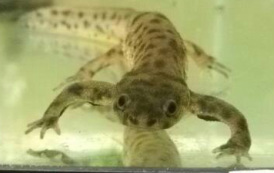
Modern analogs to early stem tetrapods have been used to infer the biology of extinct taxa, providing insight into the evolutionary history of vertebrates. Studies of salamanders have been a particular focus in examinations of locomotor function in stem tetrapods. Given that the earliest tetrapods were likely aquatic, a salamander group with greater aquatic tendencies may serve as a more appropriate model for the incipient stages of terrestrial locomotion in early stem tetrapods. Findings from a collaboration with my doctoral adviser, Rick Blob, indicated that limb kinetics of Pleurodeles waltl, a semi-aquatic newt, are generally intermediate between those of the pectoral fins of mudskipper fish (Periophthalmus barbarus) moving over land, and those of more terrestrial salamanders (Ambystoma tigrinum). These data provide a framework for modeling stem tetrapods using an early stage of rear-wheel drive, with forelimb kinetics still sharing similarities to fins.
We are currently producing a hierarchical Bayesian framework with collaborators at the University of Tennessee, and I am developing an R package to provide quantitative tools to kinematic and kinetic data in an open-source environment.
We are currently producing a hierarchical Bayesian framework with collaborators at the University of Tennessee, and I am developing an R package to provide quantitative tools to kinematic and kinetic data in an open-source environment.
Determining a mechanistic basis for differential limb function
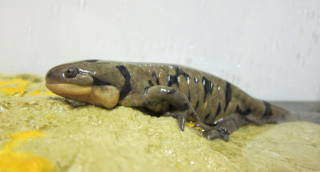
The ability of bones to resist physical demands has important implications for the functional capabilities of vertebrates. This capacity is typically greater than what is required to accomplish normal tasks. Such excess capacity, or “safety factor,” can serve as biological insurance to reduce the likelihood of failure. The “mixed-chain” hypothesis proposes that different safety factors might be found among components within a biological system due to unpredictability in the demands placed upon them, different energetic costs, or overall high safety factors of the components within the system. A collaboration with Ross Economy (Micron Technology, Inc.), Marian Kennedy (Materials Science and Engineering), Delphine Dean (Bioengineering), and Rick Blob (Biological Sciences) compared the mechanical properties and locomotor loading of the humerus and femur of tiger salamanders Ambystoma tigrinum in context of the “mixed-chain” hypothesis, in order to evaluate the conditions under which functional diversity in safety factors might emerge. Our findings suggest intraspecific variation between and within bones that may relate to the different biomechanical functions of these locomotor modules, and provide a refined context for considering the acquisition of novel locomotor capabilities during the evolutionary invasion of land by tetrapods.
This work was published in the Journal of Experimental Biology (paper), with data made available through Dryad (data).
This work was published in the Journal of Experimental Biology (paper), with data made available through Dryad (data).
Modeling the weight-bearing capabilities of fossil tetrapodomorphs
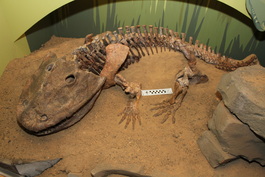
Rick Blob and I are implementing the biomechanical model that we used on our modern analogs to fossil tetrapodomorphs, in order model how the anatomical changes observed across fossil tetrapodomorphs contributed towards vertebrates becoming terrestrial.
Photo depicts Eryops, an early stem tetrapod, and is courtesy of the Cleveland Museum of Natural History.
Photo depicts Eryops, an early stem tetrapod, and is courtesy of the Cleveland Museum of Natural History.
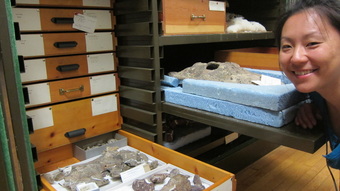
This research involved collections-based studies at several natural history museums across the USA. Here, I am studying some more specimens of Eryops at the Field Museum.
This research involved collections-based studies at several natural history museums across the USA. Here, I am studying some more specimens of Eryops at the Field Museum.
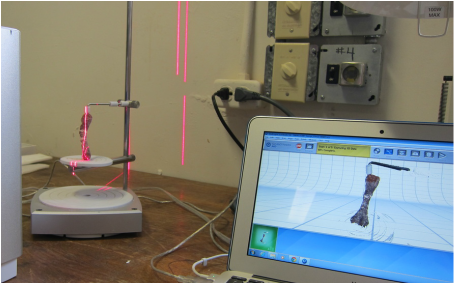
At each museum, I developed 3D models of disarticulated fossil bones of stem tetrapods using a NextEnginer laser scanner and collected data from about 50 specimens from ten species. These included some of the first 3D models of some of the museum specimens, and augmented digital repositories of research collections at these natural history museums.
